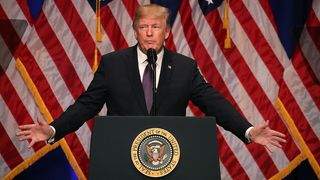The Trump administration’s first national security strategy, released yesterday, is contradictory in places and ironic in others. Its policy prescriptions, when set against the actions of Donald Trump, are of questionable credibility.
But one consistency is a more hawkish tone towards China, no longer held back to gain co-operation on North Korea. It reveals what has been a growing consensus in Washington for the past several years: that Beijing should be taken more seriously as a geostrategic rival.
If followed through, this policy will likely have significant implications for Australia, as the US aims to expand the areas in which it competes with China. Canberra’s balance between our largest economic partner and our leading security ally just got more complicated.
The Trump administration’s first national security strategy reveals what has been a growing consensus in Washington for the past several years: that Beijing should be taken more seriously as a geostrategic rival.
The security strategy argues that the US is entering a new era of great power competition with “revisionist” states — China and Russia. For several decades now, US policy has been to engage these powers, bringing them into international institutions and integrating them with the global economy. It was thought that this would, as the strategy puts it, “turn them into benign actors and trustworthy partners”. It adds that “for the most part, this premise turned out to be false”.
This shift, if followed through, will likely have the biggest impact on US-China relations. While elements of the document maintain continuity with previous administrations, this strategy seeks to go beyond the purely military and economic arenas. It says a new type of great power competition is emerging. This competition will be “continuous” — Western notions of being at “war” or “peace” are not relevant in this new rivalry, as much of it will be an ongoing struggle below the level of open armed conflict.
The strategy stresses that this competition will extend to cyberspace, through the control of information, data and technology. There is now a “contest” over information that is heightening the power, military, economic and political struggle. Data, the fuel for new technologies such as artificial intelligence, is at the centre of this. “Information statecraft” — the use of information and influence to achieve political goals — gets its own section and narrative in the new strategy.
Militarily the Trump administration argues it must “overmatch” its rivals, renewing investments in new technologies and expanding its armed forces.
The Trump administration has also elevated the contest over intellectual property and emerging technologies. It believes revisionist actors — namely China — “steal” US technological innovations and proprietary information to make up for their “own systemic weaknesses”. It aims to toughen visa requirements for foreign science, technology, engineering and mathematics students and expand the role of its foreign investment review body — a blunt policy option that may end up harming US innovation.
The strategy simultaneously derides and praises the value of international institutions and multilateral engagement. But it is consistent in saying they are arenas of competition and influence with rivals, not necessarily for mutual benefit.
Militarily the Trump administration argues it must “overmatch” its rivals, renewing investments in new technologies and expanding its armed forces.
Notably for Canberra, significant language around deterrence peppers the document. The administration believes the US must have the ability to “deter potential enemies by denial” and that allies need to do the same. And like-minded countries need to “affirm the political will to win”.
The new policy document tells us something about Washington’s mood towards Beijing. It contains elements of Trumpian policy — such as the America-first language and a focus on bilateral trade — but also reflects a bipartisan consensus on China in D.C.
Although President Trump’s actions remain a source of uncertainty, this document reveals a shift in the US foreign policy consensus from global economic integration to great power competition.
There are also echoes of ideological clash throughout. For example, at the point Australia is mentioned, it notes: “A geopolitical competition between free and repressive visions of world order is taking place in the Indo-Pacific region.” This is a significant statement. Those looking for priorities in this document would be wise to notice the rankings of regions — Indo-Pacific comes in first.
Australia is also mentioned for other reasons, such as the fact we have fought alongside the US in every significant conflict since World War I. We are mentioned again in relation to the growing co-operation between Delhi, Washington, Tokyo and Canberra, a cornerstone of the strategy’s Indo-Pacific chapter.
The document lays bare what many analysts in Australia knew has been building for several years — a more hardline policy towards China. It will likely lead to greater strain in US-China relations and, if followed through, the expanding of areas of competition will eventually find their way to Australia.
Although President Trump’s actions remain a source of uncertainty, this document reveals a shift in the US foreign policy consensus from global economic integration to great power competition. For Australia, it paints a contested Indo-Pacific region in which we play a significant role.




